Yamaha RX10LTGTX, RX10LTGTAX, RX10GTAX, RX10GTX Manual
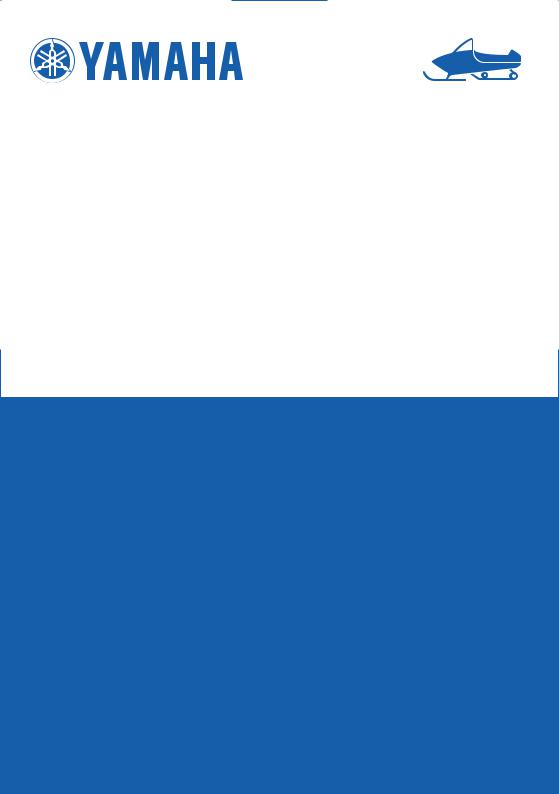
OWNER’S MANUAL
RX10GTX
RX10GTAX
RX10LTGTX
RX10LTGTAX
LIT-12628-02-64 |
8GD-28199-12 |

ESU10040

Introduction
ESU10120
Congratulations on your purchase of a Yamaha snowmobile. This model is the result of Yamaha’s vast experience in the production of fine sporting and touring snowmobiles. It represents the high degree of craftsmanship and reliability that have made Yamaha a leader in these fields.
This manual will give you an understanding of the operation, inspection, and basic maintenance of this snowmobile. If you have any questions concerning the operation or maintenance of your snowmobile, please consult a Yamaha dealer.
To maintain the high quality and performance of this snowmobile, it is important that you and your Yamaha dealer pay close attention to the recommended maintenance schedules and operating instructions contained within this manual.
RX10GTX
RX10GTAX
RX10LTGTX
RX10LTGTAX
OWNER’S MANUAL
©2007 by Yamaha Motor Corporation, U.S.A.
1st Edition, March 2007 All rights reserved.
Any reprinting or unauthorized use without the written permission of Yamaha Motor Corporation, U.S.A. is expressly prohibited.
Printed in Japan.
P/N LIT-12628-02-64

Important manual information
ESU10150
EWS00010
 WARNING
WARNING
PLEASE READ AND UNDERSTAND THIS MANUAL COMPLETELY BEFORE OPERATING THE SNOWMOBILE.
NOTE:
●Yamaha continually seeks advancements in product design and quality. Therefore, while this manual contains the most current product information available at the time of printing, there may be minor discrepancies between your snowmobile and this manual. If there is any question concerning this manual, please consult a Yamaha dealer.
●This manual should be considered a permanent part of this snowmobile and should remain with the snowmobile when resold.
Particularly important information is distinguished in this manual by the following notations.
 The Safety Alert Symbol means ATTENTION! BECOME ALERT! YOUR SAFETY IS INVOLVED!
The Safety Alert Symbol means ATTENTION! BECOME ALERT! YOUR SAFETY IS INVOLVED!
EWS00020
 WARNING
WARNING
Failure to follow WARNING instructions could result in severe injury or death to the snowmobile operator, a bystander, or a person inspecting or repairing the snowmobile.
ECS00010
CAUTION:
A CAUTION indicates special precautions that must be taken to avoid damage to the snowmobile.
NOTE:
A NOTE provides key information to make procedures easier or clearer.

Contents
Safety information ............................ |
1 |
Location of the important labels ..... |
4 |
Description ........................................ |
7 |
Control functions ............................ |
10 |
Main switch .................................. |
10 |
Throttle lever ................................ |
10 |
Engine overheating |
|
prevention system ..................... |
10 |
Throttle override system |
|
(T.O.R.S.) .................................. |
10 |
Speedometer unit ......................... |
12 |
High beam indicator light .............. |
14 |
Low coolant temperature |
|
indicator light ............................. |
14 |
Fuel meter, grip warmer level |
|
indicator, rear suspension |
|
compression damping level |
|
indicator, and thumb warmer |
|
level indicator ............................ |
14 |
Fuel level warning indicator .......... |
17 |
Oil level warning indicator ............ |
17 |
Coolant temperature warning |
|
indicator ..................................... |
18 |
Self-diagnosis device ................... |
18 |
Engine stop switch ....................... |
18 |
Headlight beam switch |
|
“LIGHTS” ................................... |
19 |
Grip warmer/rear suspension |
|
compression damping and |
|
thumb warmer adjustment |
|
switches .................................... |
19 |
Auxiliary DC jack .......................... |
19 |
Brake lever ................................... |
20 |
Parking brake lever ...................... |
21 |
Shift lever ..................................... |
21 |
Shroud and covers ....................... |
22 |
Drive guard ................................... |
23 |
V-belt holders ............................... |
23 |
Storage compartment ................... |
23 |
Fuel .............................................. |
23 |
Suspension .................................. |
24 |
Pre-operation checks ..................... |
29 |
Pre-operation check list ............... |
29 |
Operation ......................................... |
31 |
Starting the engine ....................... |
31 |
Break-in ........................................ |
31 |
Riding your snowmobile ............... |
32 |
Maximizing drive track life ............ |
35 |
Driving .......................................... |
36 |
Stopping the engine ..................... |
37 |
Transporting ................................. |
37 |
Periodic maintenance..................... |
38 |
Periodic maintenance chart for |
|
the emission control system ..... 38 |
|
General maintenance and |
|
lubrication chart ........................ |
40 |
Tool kit ......................................... |
42 |
Removing and installing |
|
the shroud and covers .............. |
42 |
Checking the spark plugs ............. |
44 |
Adjusting the engine |
|
idling speed ............................... |
45 |
Adjusting the throttle cable |
|
free play .................................... |
45 |
Checking the throttle |
|
override system (T.O.R.S.) ....... |
47 |
Checking the air filter ................... |
47 |
High-altitude settings ................... |
49 |
Valve clearance ........................... |
49 |
Engine oil and oil filter cartridge ... |
49 |
Cooling system ............................ |
53 |
V-belt ............................................ |
54 |
Drive chain housing ..................... |
57 |
Brake and parking brake .............. |
58 |
Skis and ski runners ..................... |
61 |
Steering system ........................... |
61 |
Drive track and slide runners ....... |
62 |
Lubrication ................................... |
65 |
Replacing a headlight bulb ........... |
65 |

Contents
Adjusting the headlight beams ..... |
67 |
Fittings and fasteners ................... |
67 |
Battery .......................................... |
67 |
Replacing a fuse .......................... |
67 |
Troubleshooting ............................. |
71 |
Storage ............................................ |
75 |
Specifications ................................. |
77 |
Consumer information.................... |
79 |
Identification number records ....... |
79 |
YAMAHA MOTOR |
|
CORPORATION, |
|
U.S.A. SNOWMOBILE |
|
LIMITED WARRANTY ............... |
80 |
YAMAHA EXTENDED SERVICE |
|
(Y.E.S.)....................................... |
83 |

 Safety information
Safety information
ESU10180
When you ride your snowmobile, you must know and use the following for your safety. Severe injury or death may result if you ignore any of the following.
Before operating
1.Read the Owner’s Manual and all labels before operating this snowmobile. Become familiar with all of the operating controls and their function. Consult a Yamaha dealer about any control or function you do not understand.
2.This snowmobile was not manufactured for use on public streets, roads, or highways. Such use is prohibited by law, and you could collide with another vehicle.
3.This snowmobile is designed to carry the OPERATOR ONLY.
Passengers are prohibited. Carrying a passenger can cause loss of control.
4.Do not operate the snowmobile after drinking alcohol or taking drugs. Your ability to operate the snowmobile is reduced by the influence of alcohol or drugs.
5.For safety and proper care of the snowmobile, always perform the pre-operation checks on page 29 before starting the engine. Check the throttle, brake, and steering for proper operation every time before starting the engine. Make sure that the throttle lever moves freely and it returns to the home position when it is released.
6.Apply the parking brake before starting the engine. Never drive the snowmobile with the parking brake applied. This may overheat the brake disc and reduce braking ability.
7.Do not allow anyone to stand behind the snowmobile when starting, inspecting, or adjusting the snowmobile. A broken track, track fittings, or debris thrown by the track could be dangerous to the operator or bystanders.
8.Handle fuel with care; it is HIGHLY FLAMMABLE.
●Never add fuel when the engine is running or hot. Allow the engine to cool for several minutes after running.
●Use an approved fuel container.
1

 Safety information
Safety information
●Fill the fuel tank outdoors with extreme care. Never remove the fuel cap indoors. Never fill the fuel tank indoors.
●Never refuel while smoking or in the vicinity of an open flame.
●Make sure that the fuel tank cap is closed securely after refueling. Wipe up any spilled fuel immediately.
9.If you swallow some gasoline, inhale a lot of gasoline vapor, or get some gasoline into your eyes, see your doctor immediately. If any gasoline spills on your skin or clothing, immediately wash your skin with soap and water, and change your clothes.
10.Wear protective clothing. Wear an approved helmet, and a face shield or goggles. Also, wear a good quality snowmobile suit, boots, and a pair of gloves or mittens that will permit use of your thumbs and fingers for operation of the controls.
Operation
1.Do not run the engine indoors, except when starting the engine to transport the snowmobile in or out of the building. Open the outside doors; exhaust fumes are dangerous.
2.Be careful where you ride. There may be obstacles hidden beneath the snow. Stay on established trails to minimize your exposure to hazards. Ride slowly and cautiously when you ride off of established trails. Hitting a rock or stump, or running into wires could cause an accident and injury.
3.This snowmobile is not designed for use on surfaces other than snow or ice. Use on dirt, sand, grass, rocks, or bare pavement may cause loss of control and may damage the snowmobile.
4.Avoid operating on glare ice, or on snow which has a lot of dirt or sand mixed in. Operation under such conditions will damage or result in rapid wear of ski runners, drive track, slide runners, and drive sprockets.
5.Always ride with other snowmobilers when going on a ride. You may need help if you run out of fuel, have an accident, or damage your snowmobile.
6.Many surfaces such as ice and hardpacked snow require much longer stopping distances. Be alert, plan ahead and
2

 Safety information
Safety information
begin decelerating early. The best braking method on most surfaces is to release the throttle and apply the brake gently— not suddenly.
Maintenance and storage
1.Do not leave the snowmobile on its left side for an extended period of time. Fuel may leak out from the fuel breather hose.
2.Modifications made to the snowmobile not approved by Yamaha, or the removal of original equipment may render your snowmobile unsafe for use that may cause severe personal injury. Modifications may also make the snowmobile illegal to use.
3.Never store the snowmobile with fuel in the fuel tank inside a building where ignition sources are present such as hot water and space heaters, an open flame, sparks, clothes dryers, and the like. Allow the engine to cool off before storing the snowmobile in an enclosed space.
4.Always refer to the “STORAGE” section on page 75 if the snowmobile is to be stored for an extended period.
5.Maintain or replace safety and instruction labels, as necessary.
3
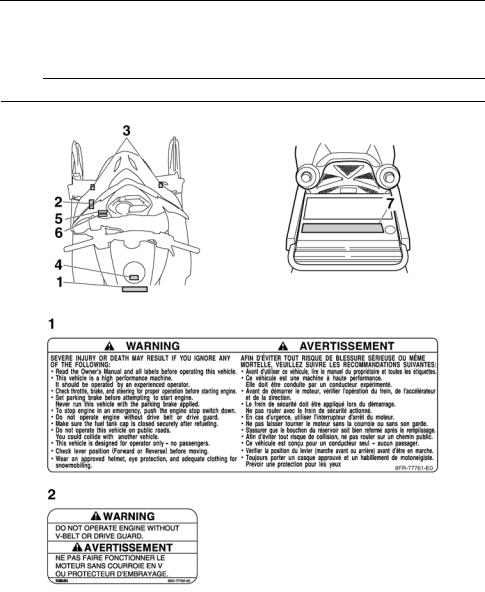
 Safety information
Safety information
ESU10231
Location of the important labels
Please read the following labels carefully before operating this snowmobile.
NOTE:
Maintain or replace safety and instruction labels, as necessary.
4
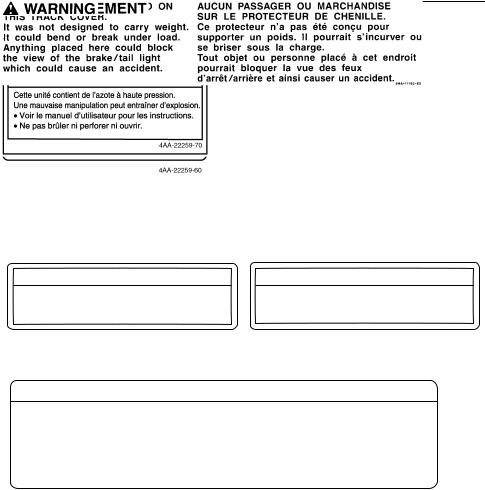
 Safety information
Safety information
3
5
CAUTION
 Cleaning with alkaline or acid cleaner, gasoline or solvent will damage windshield.
Cleaning with alkaline or acid cleaner, gasoline or solvent will damage windshield.  Use neutral detergent.
Use neutral detergent.
3JJ-2835Y-A0
4
6
ATTENTION
 Eviter de nettoyer le pare-brise avec une solution alcaline ou acide ainsi qu’avec de l’essence ou un diluant.
Eviter de nettoyer le pare-brise avec une solution alcaline ou acide ainsi qu’avec de l’essence ou un diluant.
 Utiliser un détergent neutre.
Utiliser un détergent neutre.
3JJ-2835Y-B0
7 RX10LTGT/RX10LTGTA
8HA-77762-E0
5
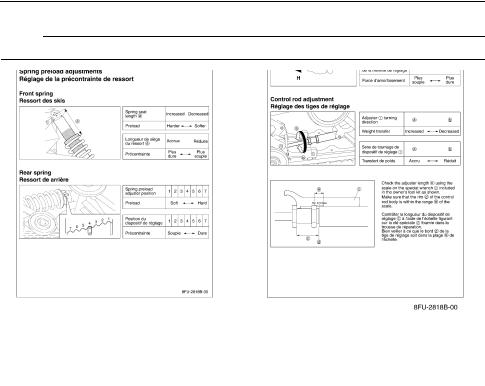
 Safety information
Safety information
NOTE:
The following suspension adjustment charts are included with the Owner’s Manual.
6
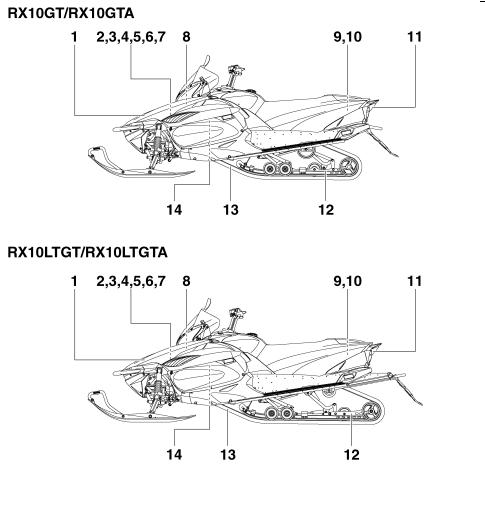
Description
ESU10260
1. |
Air filter |
12. Slide rail suspension |
2. |
Battery |
13. Drive track |
3. |
Coolant recovery tank |
14. V-belt holder |
4.Coolant reservoir
5.Fuse box
6.Main fuse
7.Oil filler cap
8.Idle adjusting screw
9.Storage compartment 10. Tool kit
11. Tail/brake lights
7

Description
1. |
Brake lever |
20. Grip warmer indicator |
2. |
Parking brake lever |
21. Fuel level warning indicator |
3. |
Grip warmer/rear suspension compression |
22. Thumb warmer indicator |
|
damping adjustment switch |
23. Oil level warning indicator |
4. |
Headlight beam switch |
24. Clock |
5. |
Engine stop switch |
25. Low coolant temperature indicator light |
6. |
Thumb warmer adjustment switch |
26. High beam indicator light |
7. |
Throttle lever |
27. Warning light |
8. |
Shift lever |
28. Speedometer |
9. |
Main switch |
29. Odometer/tripmeter/barometer |
10.Auxiliary DC jack
11.Tachometer
12.“MODE” button
13.“RESET” button
14.“SELECT” button
15.Fuel meter, grip warmer level indicator, rear suspension compression damping level indicator, and thumb warmer level indicator
16.Fuel meter indicator
17.Self-diagnosis warning indicator
18.Rear suspension indicator
19.Coolant temperature warning indicator
8

Description
NOTE:
●The snowmobile you have purchased may differ slightly from those shown in the figures of this manual.
●Design and specifications are subjected to change without notice.
9
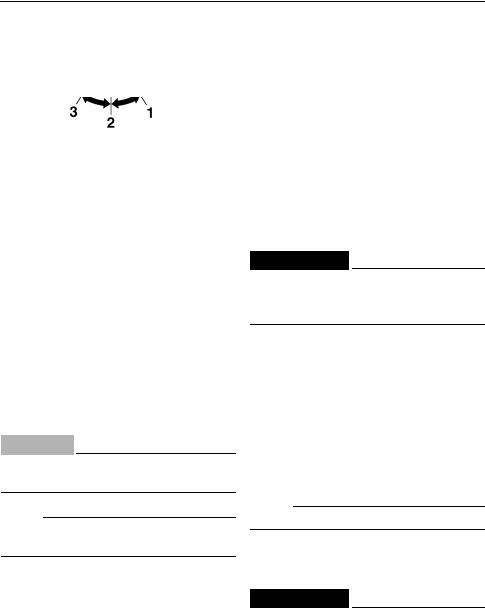
Control functions
ESU10281
Main switch
The main switch controls the ignition and lighting systems. The various positions are described below.
1.Off
2.On
3.Start
Off
The ignition circuit is switched off.
The key can be removed only in this position.
On
The ignition circuit is switched on.
Start
The starting circuit is switched on. The starter motor cranks the engine.
ECS00020
CAUTION:
Release the switch immediately after the engine starts.
NOTE:
The headlights, meter lighting, and taillights come on after the engine is started.
ESU10310
Throttle lever
Once the engine is running cleanly, squeezing the throttle lever will increase the engine speed and cause engagement of the drive system. Regulate the speed of the snowmobile by varying the throttle position. Because
the throttle is spring-loaded, the snowmobile will decelerate, and the engine will return to idle when it is released.
1. Throttle lever
EWS00030
 WARNING
WARNING
Check the throttle, brake, and steering for proper operation before starting the engine. (See page 29.)
ESU10321
Engine overheating prevention system
This model is equipped with a system, which prevents overheating when the engine is idling.
When the engine has been idling for 3 minutes or longer and the coolant temperature has risen above 100 °C (212 °F), the engine automatically stops to prevent overheating.
NOTE:
The engine can be started after it stops.
ESU10343
Throttle override system (T.O.R.S.)
EWS00040
 WARNING
WARNING
●If the T.O.R.S. is activated, make sure that the cause of the malfunction has been corrected and that the engine can be operated without a problem before restarting the engine.
10

Control functions
●Be sure to use the specified spark plug and spark plug cap. Otherwise, the T.O.R.S. will not work properly.
If the throttle bodies or throttle cable malfunctions during operation, the T.O.R.S. will operate when the throttle lever is released.
The T.O.R.S. is designed to override the fuel injection and limit the engine speed to less than the clutch engagement speed if the throttle valves fail to return to the idle position when the throttle lever is released. (See page 77 for the clutch engagement speed.)
|
Idling / |
Running |
Trouble |
|
|
starting |
|||
|
|
|
||
|
|
|
|
|
Throttle |
Off |
On |
Off |
|
switch |
||||
|
|
|
||
|
|
|
|
|
Throttle |
|
|
|
|
position |
Closed |
Open |
Open |
|
sensor |
|
|
|
|
|
|
|
|
|
Engine |
|
|
T.O.R.S. |
|
Run |
Run |
will oper- |
||
|
|
|
ate. |
|
|
|
|
|
Idling / starting
1.Throttle position sensor (throttle valve closed position)
2.Throttle switch (off)
3.Throttle cable
Running
1.Throttle position sensor (throttle valve open position)
2.Throttle switch (on)
Trouble
1.Throttle position sensor (throttle valve open position)
2.Throttle switch (off)
NOTE:
●When the T.O.R.S. is activated, the warning light and self-diagnosis warning indicator will flash, and the two-digit code “84” will flash in the clock display.
●The T.O.R.S. monitors the condition of the throttle position sensor, speedometer assembly, and speed sensor, and will operate if any of the monitored items is disconnected or is malfunctioning.
11
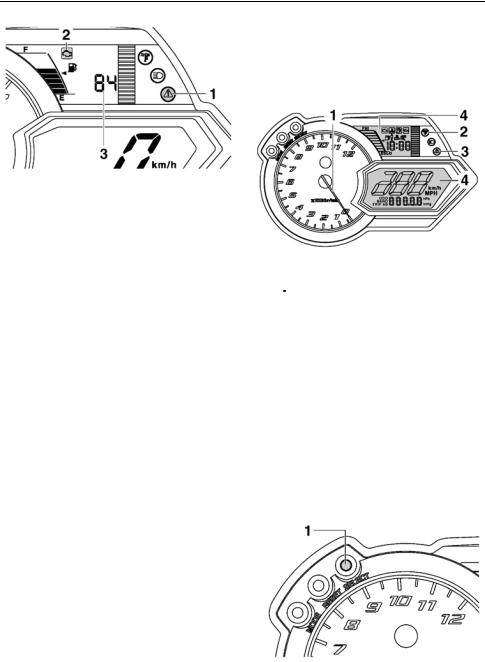
Control functions
1.Warning light “ ”
”
2.Self-diagnosis warning indicator “ ”
”
3.Two-digit code “84”
ESU12601
Speedometer unit
The speedometer unit is equipped with the following:
●a digital speedometer (which shows the riding speed)
●an odometer (which shows the total distance traveled)
●two tripmeters (which show the distance traveled since they were last set to zero)
●a barometer (which shows the ambient barometric pressure)
●a clock
●warning indicators (which show self-diag- nosis, coolant temperature, fuel level, and oil level warnings)
●a fuel meter (which shows the fuel remaining in the fuel tank)
●a grip/thumb warmer level indicator (which shows the grip warmer level or the thumb warmer level)
●a display brightness control function
●a rear suspension compression damping level indicator (which shows the compression damping force level of the electronically controlled rear shock absorber)
After the engine is started, the tachometer makes one sweep, and the low coolant temperature indicator light, the warning light, and all segments of the meter display turn on and off once.
1.Tachometer
2.Low coolant temperature indicator light
“  ”
”
3.Warning light “ ”
”
4.Meter display
The grip warmer level or the rear suspension compression damping level is initially displayed for 5 seconds according to the selected mode, then the display switches to the fuel meter.
Odometer, tripmeter, and barometer modes
Pushing the “SELECT” button switches the display between the odometer mode “ODO”, tripmeter modes “TRIP A” and “TRIP B”, and barometer mode “BARO”.
1. “SELECT” button
12
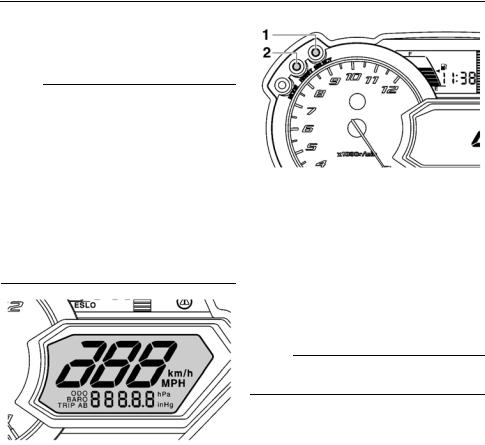
Control functions
To reset a tripmeter, push the “RESET” button for at least 1 second while the tripmeter is displayed.
NOTE:
●To switch the speedometer, odometer, and tripmeter displays between kilometers and miles, select the odometer mode “ODO”, and then push the “SELECT” button for at least 10 seconds while the snowmobile is stopped.
●To switch the barometer display between hectopascal “hPa” and inches of mercury “inHg”, select the barometer mode “BARO”, and then push the “SELECT” button for at least 3 seconds while the snowmobile is stopped.
Clock
To set the clock:
1.“SELECT” button
2.“RESET” button
2.Push the “RESET” button to change the hour setting, and then push the “SELECT” button. The minute digits will start flashing.
3.Push the “RESET” button to change the minute setting, and then push the “SELECT” button. The clock starts when the “SELECT” button is released.
NOTE:
The clock must be set again when the battery is disconnected.
Display brightness control
This function allows you to adjust the brightness of the meter display to suit the outdoor lighting conditions.
To adjust the display brightness
1.Push the “SELECT” button and “RESET” 1. Turn the main switch to the off position.
button simultaneously until the hour digits |
2. Push and hold down the “SELECT” but- |
start flashing. |
ton. |
13
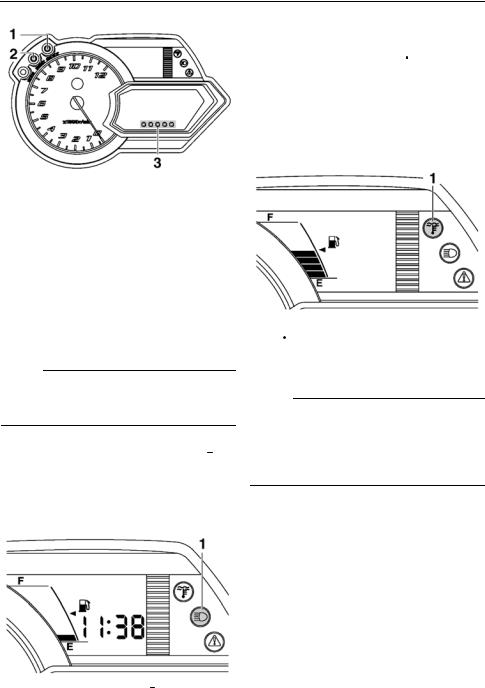
Control functions
1.“SELECT” button
2.“RESET” button
3.Display brightness level
3.Turn the main switch to the on position, and then, after 5 seconds, release the “SELECT” button.
4.Push the “RESET” button to select the desired display brightness level, and then push the “SELECT” button. The normal display returns when the “SELECT” button is released.
NOTE:
If the main switch is turned to the off position or the engine is started before completing the procedure, the setting is not applied.
ESU10410
High beam indicator light “  ”
”
The high beam indicator light comes on when the high beams of the headlights are switched on. (See page 19 for headlight beam switch operation.)
1. High beam indicator light “  ”
”
ESU10471
Low coolant temperature indicator light “ ”
”
The low coolant temperature indicator light comes on when the coolant temperature is low and informs the rider that the snowmobile should be warmed up. After the engine is started, warm it up until the indicator light goes off.
1.Low coolant temperature indicator light
“  ”
”
The snowmobile can be operated normally after the indicator light goes off.
NOTE:
Operate the snowmobile at low speeds when the low coolant temperature indicator light is on. If the engine speed is too high, maximum engine speed is reduced to protect the engine.
ESU10441
Fuel meter, grip warmer level indicator, rear suspension compression damping level indicator, and thumb warmer level indicator
The fuel meter, grip warmer level indicator, rear suspension compression damping level indicator, and thumb warmer level indicator have eight segments which show the amount of fuel remaining in the fuel tank, the grip warmer level or the thumb warmer level, and
14

Control functions
the compression damping force level of the electronically controlled rear shock absorber respectively.
1.Fuel meter, grip warmer level indicator, rear suspension compression damping level indicator, and thumb warmer level indicator
Fuel meter
The display segments of the fuel meter disappear towards “E” (Empty) as the fuel level decreases. When only one segment is left near “E”, the fuel level warning indicator and the warning light come on.
1.Fuel level warning indicator “ ”
”
2.Warning light “ ”
”
If the fuel level warning indicator and the warning light come on, refuel as soon as possible.
NOTE:
The snowmobile must be stopped on a level surface to obtain an accurate fuel meter reading, since the reading changes according to the movement and inclination of the snowmobile.
Grip warmer level indicator, rear suspension compression damping level indicator, and thumb warmer level indicator
●To display the grip warmer level indicator or the rear suspension compression damping level indicator, press the grip warmer/rear suspension compression damping adjustment switch. To switch between the two level indicators, press the “MODE” button twice.
●To display the thumb warmer level indicator, press the thumb warmer adjustment switch.
1.Grip warmer indicator “  ”
”
2.Rear suspension indicator “  ”
”
3.Thumb warmer indicator “  ”
”
15

Control functions
1.Grip warmer/rear suspension compression damping adjustment switch
1. “MODE” button
1. Thumb warmer adjustment switch
NOTE:
●The grip warmer, rear suspension compression damping, and thumb warmer levels are displayed for 5 seconds after releasing the corresponding adjustment switch, then the display switches to the fuel meter.
●The top segment of the fuel meter, grip warmer level indicator, rear suspension compression damping level indicator, and thumb warmer level indicator flashes once when the corresponding adjustment reaches the maximum level. The bottom segment of the fuel meter, grip warmer level indicator, rear suspension compression damping level indicator, and thumb warmer level indicator flashes once when the corresponding adjustment reaches the minimum level.
●When the engine is started, the grip warmer, rear suspension compression damping, and thumb warmer levels are set to the levels selected when the engine was stopped.
To adjust the grip warmer temperature
1.Push the “MODE” button and make sure that the grip warmer indicator is displayed. If the rear suspension indicator is displayed, push the “MODE” button again to display the grip warmer indicator.
1.Grip warmer indicator “  ”
”
2.Rear suspension indicator “  ”
”
2.To raise the temperature, press the grip warmer/rear suspension compression damping adjustment switch to “HI”, and to lower it, press the switch to “LO”.
16
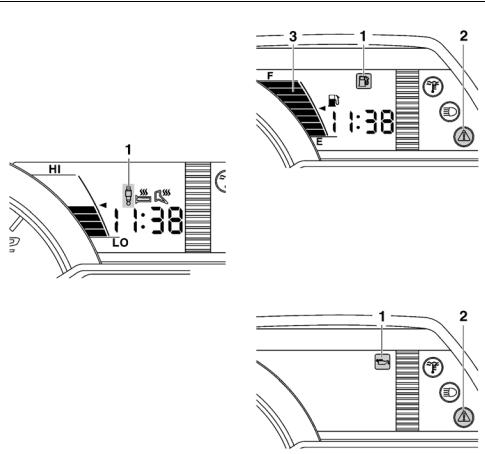
Control functions
To adjust the rear suspension compression damping level
1.Push the “MODE” button and make sure that the rear suspension indicator is displayed. If the grip warmer indicator is displayed, push the “MODE” button again to display the rear suspension indicator.
1.Rear suspension indicator “  ”
”
2.To increase the compression damping force, press the grip warmer/rear suspension compression damping adjustment
switch to “HI”, and to decrease it, press the switch to “LO”.
To adjust the thumb warmer temperature
To raise the temperature, press the thumb warmer adjustment switch to “HI”, and to lower it, press the switch to “LO”.
ESU10450
Fuel level warning indicator “ ”
”
The fuel level warning indicator indicates a malfunctioning sensor, disconnected coupler, broken lead, or short circuit when detected by the self-diagnosis device of the snowmobile.
The fuel level warning indicator, warning light, and all segments of the fuel meter warn the rider of the above problems by flashing continuously.
When this occurs, have a Yamaha dealer inspect the snowmobile as soon as possible.
1.Fuel level warning indicator “ ”
”
2.Warning light “ ”
”
3.Fuel meter
ESU10460
Oil level warning indicator “ ”
”
The oil level warning indicator and the warning light come on when the engine oil level is low.
1.Oil level warning indicator “  ”
”
2.Warning light “ ”
”
If the oil level warning indicator and the warning light come on, place the snowmobile on a level surface and allow it to idle for one minute.
If the oil level warning indicator and the warning light go off, the engine oil level is sufficient, however it is getting low. Add engine oil as soon as possible.
If the oil level warning indicator and the warning light do not go off, check the engine oil level in the oil tank (see page 49 for engine oil level checking procedures), and add engine oil if necessary.
17
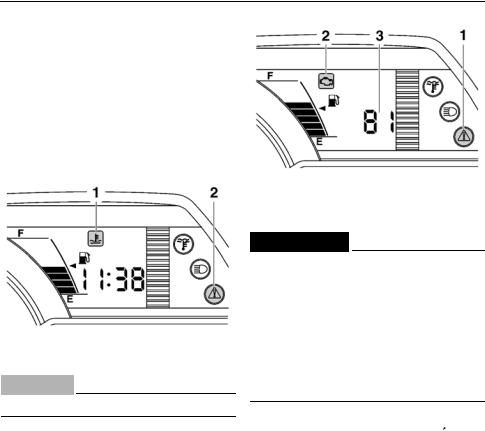
Control functions
ESU10511
Coolant temperature warning indicator “ ”
”
If the engine overheats, the coolant temperature warning indicator and the warning light come on. When this occurs, stop the engine immediately and allow the engine to cool down, and then check the coolant level in the coolant reservoir. (See page 53 for checking procedures.)
1.Coolant temperature warning indicator “ ”
”
2.Warning light “ ”
”
ECS00040
CAUTION:
Do not operate the engine if it overheats.
ESU12680
Self-diagnosis device
This model is equipped with a self-diagnosis device for various electrical circuits.
If any of those circuits are defective, the warning light and the self-diagnosis warning indicator will flash, and a two-digit error code will flash slowly in the tripmeter/odometer display.
1.Warning light “ ”
”
2.Self-diagnosis warning indicator “ ”
”
3.Two-digit error code
EWS00650
 WARNING
WARNING
If the self-diagnosis warning indicator and warning light flash continuously, and an error code is displayed during operation, there may be some problem with an electrical circuit, couplers, etc.
Note the error code, and then have a Yamaha dealer inspect the snowmobile as soon as possible in order to avoid engine damage.
ESU10530
Engine stop switch “ ”
”
The engine stop switch is used to stop the engine in an emergency. Simply push the stop switch to stop the engine. To start the engine, pull the stop switch and proceed with starting the engine. (See pages 31 for engine starting procedures.)
18

Control functions
1. Engine stop switch“ ”
”
During the first few rides, practice using the stop switch so that you can react quickly in an emergency.
ESU10661
Headlight beam switch “LIGHTS”
Push the headlight beam switch to change the headlight to high beam “HI” or to low beam “LO”.
1.Headlight beam switch “LIGHTS”
2.High beam “HI”
3.Low beam “LO”
ESU12710
Grip warmer/rear suspension compression damping and thumb warmer adjustment switches
These switches are used to adjust the grip warmer, rear suspension compression damping and thumb warmer levels.
See “Fuel meter, grip warmer level indicator, rear suspension compression damping level indicator, and thumb warmer level indicator” on page 14 for detailed information.
1.Grip warmer/rear suspension compression damping adjustment switch
1. Thumb warmer adjustment switch
ESU10690
Auxiliary DC jack
The auxiliary DC jack is located in the front panel and can be used for accessories.
NOTE:
The auxiliary DC jack cannot be used if the engine is not running.
To use the auxiliary DC jack
1.Start the engine.
2.Open the auxiliary DC jack cap, and then insert the accessory power plug into the jack.
19
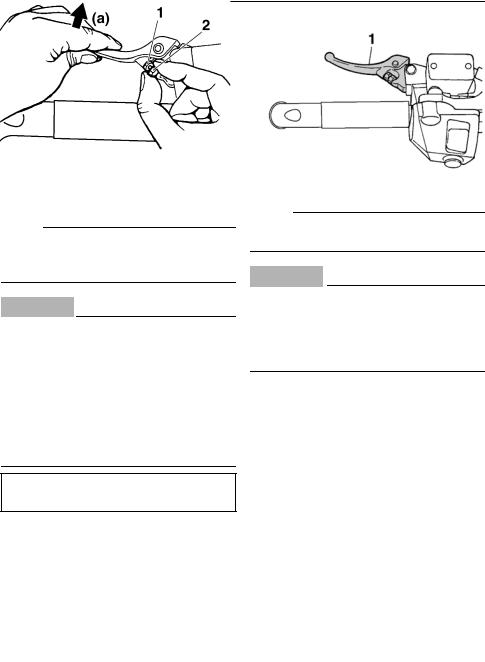
Control functions
1.Auxiliary DC jack cap
2.Auxiliary DC jack
NOTE:
After using the auxiliary DC jack, be sure to remove the accessory power plug from the jack and close the auxiliary DC jack cap.
ECS00120
CAUTION:
●Do not use accessories requiring more than the maximum rated capacity for the auxiliary DC jack. This may overload the circuit and cause the fuse to blow. (See page 67 for the specified amperage.)
●Do not use an automotive cigarette lighter or other accessory with a plug that gets hot because the jack can be damaged.
Maximum rated capacity:
DC 12 V, 2.5 A (30 W)
ESU10560
Brake lever
The snowmobile is stopped by braking the entire drive system.
Squeeze the brake lever towards the handlebar grip to stop the snowmobile.
1. Brake lever
NOTE:
When the brake lever is operated, the brake light will illuminate.
ECS00060
CAUTION:
Make sure that the brake lever end does not project out over the handlebar end. This will help prevent brake lever damage when the snowmobile is placed on its side for service.
The brake lever is equipped with a position adjuster.
To adjust the brake lever position:
1.Loosen the locknut.
2.While lightly pushing the brake lever in direction (a), finger tighten the adjusting bolt to set the brake lever to the desired position.
1.Locknut
2.Adjusting bolt
20
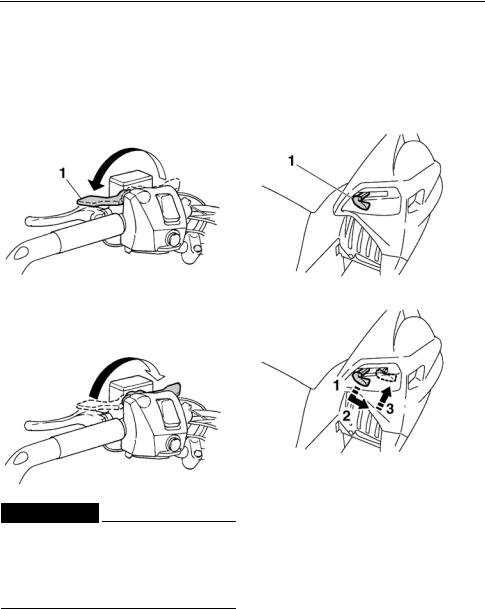
Control functions
3.Tighten the locknut securely after adjust-
ing the brake lever.
ESU10580
Parking brake lever
When parking the snowmobile or starting the engine, apply the parking brake by moving the parking brake lever to the left.
1. Parking brake lever
To release the parking brake, move the parking brake lever to the right.
EWS00060
 WARNING
WARNING
●Always set the parking brake before attempting to start the engine.
●Never run the snowmobile with the parking brake applied. This may overheat the brake disc and reduce braking ability.
ESU10590
Shift lever
The shift lever is used to put the snowmobile into forward or reverse. After coming to a complete stop, pull the shift lever out, slide it to “FWD” or to “REV” until it stops, and then release it.
1. Shift lever
1.Pull out.
2.Slide to “FWD” (forward).
3.Release.
21
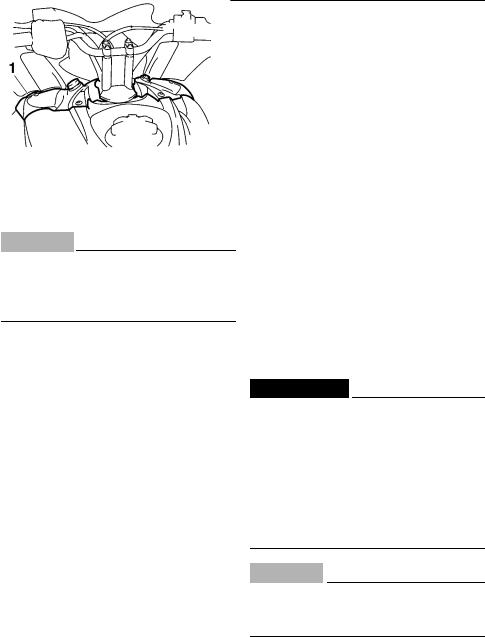
Control functions
1.Pull out.
2.Slide to “REV” (reverse).
3.Release.
ECS00070
CAUTION:
Do not shift from “FWD” to “REV” or from “REV” to “FWD” while the snowmobile is moving. Otherwise, the drive system could be damaged.
ESU10720
Shroud and covers
Securely fasten the shroud and covers before operating the snowmobile. (See page 42 for removal and installation procedures.)
1.Shroud
2.Right side cover
1. Left side cover
1. Top cover
EWS00090
 WARNING
WARNING
●Do not drive the snowmobile with the shroud or covers unfastened or removed.
●Keep your body and clothing away from rotating parts when servicing the snowmobile with the shroud or covers removed.
●Do not touch the hot muffler and engine during or immediately after operation.
ECS00370
CAUTION:
Make sure that all cables, leads, etc., are routed properly before installing the shroud and covers.
22
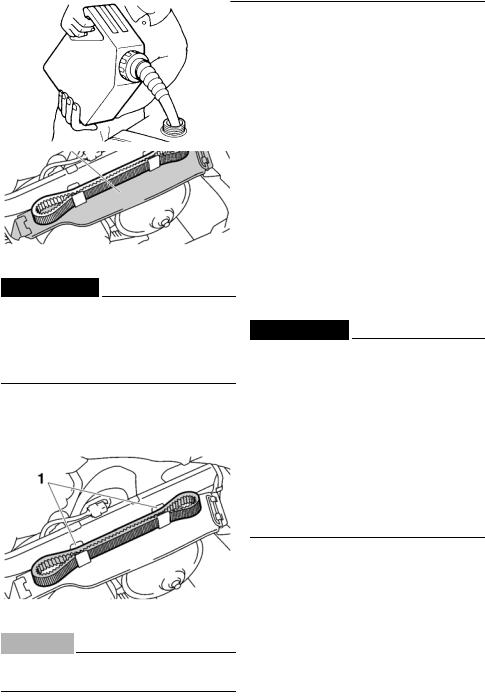
Control functions
ESU10750
Drive guard
The drive guard is designed to cover the V- belt clutch and V-belt in case parts break or come loose.
1. Drive guard
EWS00400
 WARNING
WARNING
●Make sure that the drive guard is tightened securely before operating the snowmobile.
●Never run the engine with the V-belt or drive guard removed.
ESU10760
V-belt holders
Keep a spare V-belt for emergency use by placing it into the V-belt holders provided.
1. V-belt holder
ECS00180
CAUTION:
Make sure that the V-belt is installed securely in the holders.
ESU10810
Storage compartment
Open the storage compartment to store the tool kit, spare parts, or other small items.
1. Storage compartment
ESU10600
Fuel
Make sure that there is sufficient fuel in the fuel tank.
EWS00070
 WARNING
WARNING
●Fuel is HIGHLY FLAMMABLE and poisonous. Check the “SAFETY INFORMATION” section carefully before refueling. (See page 1.)
●Do not fill the fuel tank above the bottom of the filler tube. Fuel could overflow if the snowmobile is tilted or if the ambient temperature rises, causing the fuel to warm up and expand.
●Make sure that the fuel tank cap is closed securely after refueling. Leaking fuel can catch fire.
23
